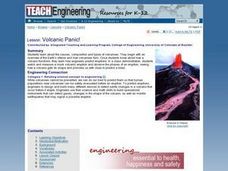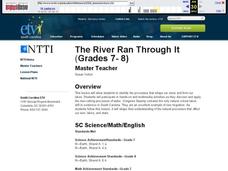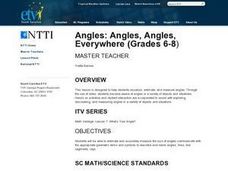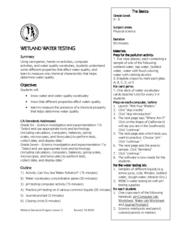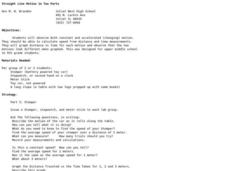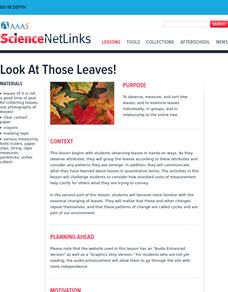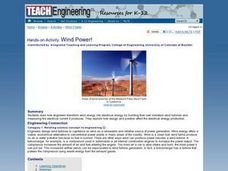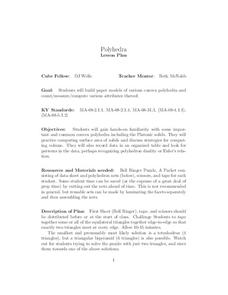Curated OER
Volcanic Panic!
Students begin with an overview of the Earth's interior and how volcanoes form. They learn how engineers predict eruptions. In a class demonstration, students watch and measure a mock volcanic eruption and observe the phases of an...
Curated OER
Keep Your Bubbles Up
Students investigate design and the correct use of technology. In this chemistry instructional activity, students investigate the Bernoulli Principle using hands on bubble making. They link the principle that keeps the bubble aloft to...
Curated OER
The River Ran Through It
Young scholars identify the processes that shape our rivers and form our lakes. They participate in hands-on and multimedia activities as they discover and apply the river-cutting processes of water.
Curated OER
Angles: Angles, Angles, Everywhere
Students practice estiminating and measuring angles. After watching a short video, they identify angles in objects in the classroom and their homes. In groups, they participate in activities in which they are given a scenerio and are...
Curated OER
Volume and Surface Area: Which Is More?
Learners explore the volume and surface area of three dimensional figures. Through the use of video, students discover three dimensional shapes, their uses in real-life applications, and methods used to calculate their volume and surface...
Curated OER
Force And Motion With Cars
Students discover that different things move at different speeds. They compare the distance a car travels on a ramp with and without a push. They
push the car with one finger the first time, let it move without a
push the next time (no...
Curated OER
Wetland Water Testing
Students examine the different properties that affect water quality. In this pollution lesson plan students play a game, complete a hands on activity and computer lab.
Alabama Learning Exchange
How Old Is That Tree?
Fifth graders study environmental changes by examining the annual rings of a cross-section of a tree trunk. They access websites to complete a worksheet on the parts of a tree. They count the annual rings on a tree slice while observing...
Curated OER
Radiation and Color
Tenth graders explore the relationship between color and heat absorption by measuring the temperature change of water in differently colored test tubes as they are exposed to a heat lamp. They work in small groups to collect data and...
Curated OER
Introduction to Field Mapping with a Compass and Pace
Students practice using compass and calibrate their own pace, take field measurements of pre-set course with compass and pace, convert measurements into map, using angles and vectors, and make composite class map by adjusting different...
Curated OER
The Interplanetary Magnetic Field (IMF)
Students design an experiment for NASA's STEREO/IMPACT mission to measure the interplanetary magnetic field. This lesson includes 3 excellent hands-on and critical thinking activities in which students explore magnetism in the solar wind.
Curated OER
TE Activity: Build an Anemometer
Students determine what an anemometer is and how it measures wind speed. They decide on a place to put a wind turbine by using an anemometer. They examine the role that engineers play when using wind speed to determine a place for wind...
Alabama Learning Exchange
Mr. Crocodile's Busy Day
Demonstrate how to read analog and digital clocks to the hour in this time measurement lesson. Read the book What Time is it Mr. Crocodile? and use Mr. Crocodile's schedule to practice telling time. They work in cooperative groups to...
Curated OER
Heart Rate
Learners move through a variety of locomotor skills at different paces to see how they affect their heart rate. In this health, human body, and physical activity lesson plan, students measure their heart rate and discuss health. A...
Curated OER
Straight Line Motion in Two Parts
Students describe and quantify the motion of toy cars. In this motion lesson, students observe a battery powered toy car on a flat surface and a standard toy car on a sloped surface. They write their observations, measure average speeds,...
Curated OER
Look At Those Leaves!
Learners observe, measure, and sort tree leaves. They examine leaves individually, in groups, and in relationship to the entire tree. They become familiar with the seasonal changing of leaves. They realize that these and other changes...
Curated OER
Wheeling It In!
Students use everyday materials (milk cartons, water bottles, pencils, straws, candy) to build a small-scale transportation device that incorporates the wheel and axle and the lever. They race their carts/trucks, measure distance, time...
Curated OER
Thar She Blows!: Wind Power
Students examine how wind energy is transformed into electrical energy. In pairs, they build miniature wind turbines and measure how much electrical current they produce. They asses the importance of design and position in energy...
Curated OER
What's My Pattern?
Learners recognize, describe and extend patterns in three activities. They organize data, find patterns and describe the rule for the pattern as well as use the graphing calculator to graph the data to make and test predictions. In the...
Curated OER
What's in the Soil?
Fourth graders examine soil to find its contents, and how much water and air they can measure. In this soil composition lesson, 4th graders perform three experiments and record their results. In one experiment they examine...
Curated OER
Creeping and Crawling Observing Mealworms and Earthworms
Students observe the inherited traits in earthworms and mealworms. In this organisms lesson, students view a live mealworm and earthworm on a tray and identify the body parts. Students measure the worms and observe the behavior....
Curated OER
Comparing Data
Eighth graders create a survey, gather data and describe the data using measures of central tendency (mean, median and mode) and spread (range, quartiles, and interquartile range). Students use these measures to interpret, compare and...
Curated OER
Polyhedra
Young scholars analyze convex polyhedra through hands on methods. In this geometrical shapes lesson, students construct paper models of convex polyhedra and identify the different properties including the number of sides, faces and edges.
Curated OER
The Physics of Sound: How We Produce Sounds
Young scholars are introduced to how they produce sounds. In groups, they participate in experiments in which they measure sound and identify their five senses. Individually, they make their own musical instruments using different...
